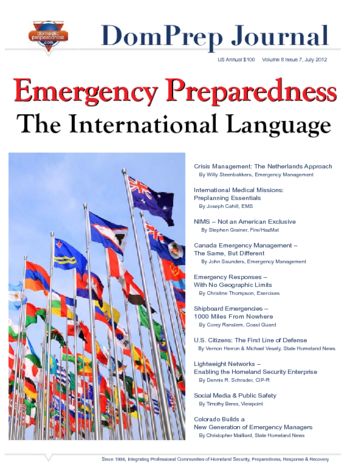

Shipboard Emergencies – 1000 Miles From Nowhere
Corey Ranslem
July 25, 2012
In 1990, a cruise ship travelling from Norway to Denmark – the Scandinavian Star – turned into a “floating fireball” within 45 minutes after a small hallway fire erupted, resulting in 158 deaths. Better ship construction and new maritime training standards target such disasters and help prevent future tragedies with adequate training of personnel and equipment and better crew communication both onboard as well as with shore-side responders.

Lightweight Networks – Enabling the Homeland Security Enterprise
Dennis R. Schrader
July 24, 2012
One of the geniuses of “the American system” is the frequently complex working relationships between the federal branch of government and the private sector. More than two centuries of experience show that coordination, cooperation, and collaboration continue to be the keys to eventual success – despite some complications from time to time.

Colorado Builds a New Generation of Emergency Managers
Christopher Mailliard
July 23, 2012
The next generation of first responders is starting earlier and growing faster, thanks in large part to new educational initiatives. High school now offers not only initial emergency management courses, but also classroom training with hands-on operational experience, college credits, and opportunities for a broad range of professional careers.

Harris Corporation Conducts First Nationwide Public Safety LTE Demonstration
Domestic Preparedness
July 20, 2012
Harris Corporation has successfully conducted the first live, multi-state demonstration that
showcased the powerful capabilities of 700 MHz Band LTE (Long Term Evolution) for first responders.
Users at multiple sites across the United States tapped into the LTE network to share streaming video,
voice, mapping and presence to support various simulated mission-critical surveillance operations.

U.S. Citizens: The First Line of Defense
Vernon Herron and Michael Vesely
July 18, 2012
Today, as in the Colonial era, homeland defense and emergency management begin at home. Homeowners and their neighbors are often the first responders available when disaster strikes. Whether they are ready to meet that challenge is not always certain, but individual citizens are starting to learn the fundamentals of planning, preparedness, response, and recovery.

Canada Emergency Management – The Same, But Different
John Saunders
July 18, 2012
As one of the largest countries in the world in terms of its land area, Canada creates a geographic challenge for emergency managers. Its ten provinces and three territories encompass

Emergency Responses – With No Geographic Limits
Christine Thompson
July 18, 2012
In sailing-ship days, it took three months or more to send a message from the United States to New Zealand. Today, those countries are only a mouse click away, as the citizens of Chicago and Christchurch gratefully found out when both major cities were hit hard, and almost simultaneously, by weather disasters of colossal magnitude.

NIMS – Not an American Exclusive
Stephen Grainer
July 18, 2012
“Management” is in many ways an abstract and somewhat generic term, but most citizens have a
general understanding of what the word means. Whether the relatively new U.S. National Incident
Management System (NIMS) is of American origin or not is perhaps debatable, but the concept itself is
nonetheless useful in many countries around the world.

Social Media & Public Safety
Timothy Beres
July 11, 2012
The new education must teach the individual how to classify and reclassify information, how to evaluate its veracity, how to change categories when necessary, how to move from the concrete

International Medical Missions: Preplanning Essentials
Joseph Cahill
July 11, 2012
An earthquake devastates Haiti, a tsunami smashes into northeast Japan, tornadoes rip through major U.S. cities – all of these disasters attracted responders from around the world who had volunteered to help in the aftermath. Some of the volunteers were well prepared and went through proper channels, but others created additional work for the authorities responsible for ensuring the safety and security of responders and survivors alike.

